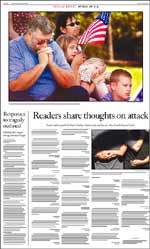Fall 2001
E-mail Swiftly Localizes WTC Attack
By Ken Sands
The Spokesman-Review
Interactive Editor
It was a devastating national tragedy with significant local impact.
Hundreds of local readers and viewers had personal connections to people affected by the Sept. 11 terrorism on the World Trade Center and the Pentagon.
In Spokane, Barbara Green was frantic about her daughter, an American Airlines flight attendant.
Shirley Cornelius of nearby Colfax, WA, knew that her brother-in-law was in the air, piloting an American Airlines flight from Europe to the United States.
And Nancy Plourde of Spokane knew that her cousin’s husband had just escaped his office high in the World Trade Center when the first building collapsed.
Dozens of such personal accounts appeared in The Spokesman-Review and on its Web site within hours of the terrorist attacks. The newspaper, like many others, published a special afternoon edition. Its Web site was continuously updated.
How did the paper quickly find personal accounts to localize the story? It took advantage of interactive tools being developed in newsrooms around the country.
The Spokesman-Review has a database with the e-mail addresses of 2,700 readers. At 9:19 a.m., the newspaper began sending messages to nearly 1,000 readers, asking for their thoughts on the attacks and whether they knew of anyone in danger.

The response was impressive. By deadline Tuesday night, 166 people responded. Twenty personal stories were published in a special “Voices” column on the news pages. Another 15 comments appeared as letters to the editor. Nearly all of the comments were posted on the Web.
The Eastside Journal in Bellevue, WA, had similar success on a smaller scale. Editoral Page Editor Craig Groshart sent e-mail to all 194 people in his database of letters-to-the-editor writers.
“Within 30 minutes I had five responses,” Groshart said. “Within two days we had nearly 50 letters, most of them people responding to the e-mail note. A number of letter writers appreciated our contacting them for their thoughts. I think they need to vent and this gives them the chance.”
Tampa Bay Online, which shares a newsroom with The Tampa Tribune and News Channel 8, also solicited e-mail.
“Not sure how people would react to the attacks, we took a thoughtful approach to how we would solicit comments,” said Peter Howard, News and Special Projects Team Leader at Tampa Bay Online (TOB).
“We rejected just posting a bulletin board. Instead, we solicited e-mails so we could take the temperature of the comments and not allow unedited vulgar or racist comments to surface.
“Less than a handful of the more than 100 responses we received in the first two days had to be rejected.”
The Kansas City Star solicited letters, reader voices and Web site “talk-back” comments. The response was immediate.
Reader Dwight Carlson of Kansas City wrote: “The irony of watching Peter Jennings describe today’s death toll and then seeing the lottery numbers scroll underneath the screen was almost too much to bear.”
These kinds of interactive tools “provide a forum for people to talk about their emotions, to relay top-of-mind thoughts during a difficult time, when many are searching for avenues to express anxiety, sympathy, anger and rage,” said TOB’s Howard.
After the initial e-mail flurry, The Spokesman-Review used its database to explore these issues:
- What actions were readers taking
to cope? - How will the attacks change
people’s travel plans? - How much freedom would people
trade off for safety? - Do people feel a greater sense of
patriotism? - Was it appropriate that local high
school football games were played on
the National Day of Mourning?
In the first four days of the crisis, the newspaper sent out messages to 3,002 readers and received 511 replies. (Only about 300 readers received more than one message that week.)
The biggest challenge was to manage all of the replies. Some comments were routed to the letters page. Most went straight to the Web site. The best of the rest were edited into a 20- to 30-inch package for the news pages. The “Voices” column became very much like a news story, with all but the quotes stripped out.
Spokesman-Review Editor Chris Peck said the online outreach added an important new dimension to coverage of the tragedy. “An important story in this disaster involves the way Americans have coped with this crisis. Our e-mail questions and interactions gave our newspaper an instant, in-depth sense of what our readers were thinking about these events. We created a new kind of story that had multiple local sources with up-to-date responses.
“This was a fantastic new journalistic tool.”
________________________
Sands coordinates the newspaper’s e-mail solicitation program. Contact him at kens@spokesman.com or 800-789-0029, ext. 5014.
